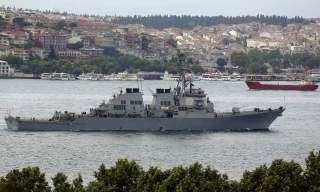F-35, Lasers, Hypersonic Missiles and More: How the Navy Will Fight the Next War
A plan is emerging.
The Point: No enemy of America is safe. None.
(Washington, D.C.) Hypersonic attack weapons, laser-armed surface ships, F-35 equipped amphibs, new long-range radar, Tomahawk missiles built to attack moving targets and drone fleets are all key emerging technologies woven into the Navy's new "offensive" attack strategy, designed to prepare for and win the wars of the future, Navy senior leaders said.
"Today we are moving to the offensive. We are already moving out on an increase in lethality," Vice. Adm. Rich Brown, Command, Naval Surfaces Forces, told an audience Jan. 14 at the Surface Navy Association Annual Symposium.
The concept is grounded upon a decided paradox ... be ready to fight and kill today and tomorrow... to keep the peace. Within this strategic framework, Brown cited a handful of specific weapons systems intended to bring this vision to fruition and essentially prevent major war. It is no surprise that this kind of deterrence focus would take center stage in the often discussed era of “great power competition,” a global environment now inspiring the U.S. to make its best effort to stay in front of major rivals such as Russia and China.
Brown cited that the "Navy was now putting lasers on ships," and went on to mention the maritime strike Tomahawk, SM-6 missile, DDG Flight III Destroyers (new high-tech heavily armed Navy destroyers) and the services' new, far more sensitive SPY-6 radar.
"We are the most visible sign of American intent to keep the peace," Brown added.
The Tomahawk missile has been an effective attack weapon for decades, providing the technical basis for the Navy's current effort to fast-track the Maritime Strike Tomahawk. This new weapon takes the existing Block IV Tomahawk to a new level by adding new seeker and guidance technology - enabling the weapon to hit moving targets at sea. This is a substantial step forward in attack capability, as it will give sea commanders the option to hit enemy ships on the move from hundreds of miles away. The existing Tomahawk, while armed with GPS guidance, a 900-mile range, drone-like loitering ability and two-way targeting data link is used as a way to attack fixed targets such as enemy buildings, command and control or other facilities.
Now, as referred to by Brown, the Tomahawk will be able to hit an entirely new envelope of targets. Another weapons system mentioned by Brown was the SM-6 missile. This weapon, now being acquired in greater numbers by the Navy, has both offensive and defensive functions. The missile can track and intercept incoming enemy missile threats and also use airborne sensor platforms to target and attack moving enemy targets. The weapon functions as an integral part of a cutting edge Navy system now deployed at sea called Naval Integrated Fire Control Counter Air; this system uses ship-based radar and an aerial surveillance platform such as a Hawkeye surveillance plane or F-35 to find and destroy approaching enemy targets beyond the horizon, threats not otherwise visible by line of sight radar or sensor systems.
Brown also cited the arrival of the F-35 to maritime warfare as a transformative attack possibility. Just last year, Brown explained, the USS America amphibious assault ship traveled the seas armed with 13 F-35s. This brings an unprecedented measure of air attack and surveillance possibilities, to include the option to provide stealth air attack support to amphibious assaults. Amphibs could offer a smaller, more mobile type of aircraft carrier power projection capability, Brown explained.
"A big deck with that many F-35s is beginning to look like an aircraft carrier to me," Brown told the audience.
Chief of Naval Operations Adm. Michael Gilday reinforced the idea of pursuing an increased offensive attack strategy as a way to "keep the peace" and protect the international waterways.
"We must have credible forces and demonstrate the will to use them....so that we achieve deterrence and do not have to use them," Gilday told the audience.
This article by Kris Osborn originally appeared in WarriorMaven in 2020.
Kris Osborn previously served at the Pentagon as a Highly Qualified Expert with the Office of the Assistant Secretary of the Army - Acquisition, Logistics& Technology. Osborn has also worked as an anchor and on-air military specialist at national TV networks. He has appeared as a guest military expert on Fox News, MSNBC, The Military Channel and The History Channel. He also has a Masters Degree in Comparative Literature from Columbia University.
Image: Reuters

